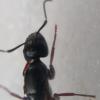- Formiculture.com
- Forums
- Gallery
- Members
- Member Map
- Chat

Two different ant species that may actually help each other
Started By
OhNoNotAgain
, Jul 24 2021 10:35 PM
4 replies to this topic
#1
 Offline
-
Posted July 24 2021 - 10:35 PM
Offline
-
Posted July 24 2021 - 10:35 PM
https://www.newscien...er-in-one-nest/
Kind of unusual to read about two species that may be mutualistic.
In this case Platythyrea conradti builds and the much smaller Strumigenys maynei acts as small yappy guard dog.
Kind of unusual to read about two species that may be mutualistic.
In this case Platythyrea conradti builds and the much smaller Strumigenys maynei acts as small yappy guard dog.
- Ecan and olookitsme like this
Formiculture Journals::
Veromessor pergandei, andrei; Novomessor cockerelli
Camponotus fragilis; also separate journal: Camponotus sansabeanus (inactive), vicinus, laevigatus/quercicola
Liometopum occidentale; Prenolepis imparis; Myrmecocystus mexicanus (inactive)
Pogonomyrmex subnitidus and californicus (inactive)
Tetramorium sp.
Termites: Zootermopsis angusticollis
Isopods: A. gestroi, granulatum, kluugi, maculatum, vulgare; C. murina; P. hoffmannseggi, P. haasi, P. ornatus; V. parvus
Spoods: Phidippus sp.
#2
 Offline
-
Posted July 24 2021 - 10:39 PM
Offline
-
Posted July 24 2021 - 10:39 PM
interesting
1X Pogonomyrmex occidentalis 40-50 Workers
1X Solenopsis molesta 10 Workers (mono)
Ants I Want: Crematogaster sp, Camponotus Sp., Ponera Pennsylvanica, Mymercocystus sp.
My Youtube channel: https://www.youtube....kUjx-dPFMyVqOLw
Join Our Fledgling Discord Server https://discord.com/...089056687423489
#3
 Offline
-
Posted July 25 2021 - 11:46 AM
Offline
-
Posted July 25 2021 - 11:46 AM
Interesting! This may not be an uncommon occurrence. Last summer I came upon two species of widely divergent size in my patio that appeared to be cooperatively foraging to the point of the smaller species venturing un-challenged, into the larger species’ nest. I couldn’t believe this hadn’t sparked an all out war. It got me to reading and I came upon this paper:
https://www.jstor.org/stable/3565636
I summarized it here: https://www.formicul...orage/?p=160173
It’s a small step from positioning one’s colony nearby for cooperative foraging to cohabitation.
Edited by ConcordAntman, July 25 2021 - 5:56 PM.
#4
 Offline
-
Posted July 29 2021 - 7:15 AM
Offline
-
Posted July 29 2021 - 7:15 AM
Super interesting. Hmmm... Wonder what all the benefits are.
#5
 Offline
-
Posted July 29 2021 - 4:51 PM
Offline
-
Posted July 29 2021 - 4:51 PM
In regards to the paper, starting with the three broad hierarchical groups; territorials (who protect their nest, food resources, and territory), encounterers (who protect their nest and food resources), and submissives (who protect only their nest). Submissives find protection and potentially access to food resources the territorials by living near territorials since the territorials control the space while the territorials don’t perceive the submissives as a threat. The same isn’t true for the encounterers since there would be conflict with territorials over food resources, but the encounterers and submissives could coexist and still gain an element of protection while not being perceived as a threat. Two submissives could also coexist and share food resources.
- cap_backfire likes this
1 user(s) are reading this topic
0 members, 1 guests, 0 anonymous users

















